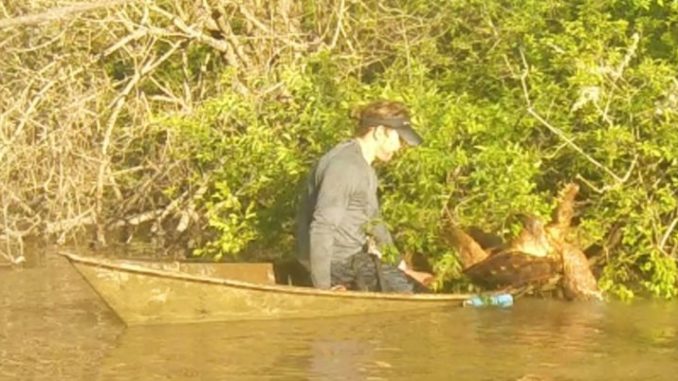
Chauvin got 101-pounder in boat – briefly
My buddy and I once saw some holes in a steep bank during a low-water period that looked great for noodling catfish. So before the summer months arrived when I went spearfishing for cats, I decided to try some noodles near the holes.
What I ended up hooking was larger than a catfish, and quickly made us rethink out plans to stick our hands in those holes — alligator snapping turtles.
These elusive large snappers are something I enjoy hunting every spring. But this year I took my adventure to the next level by going after these big turtles with a pirogue instead of using my bay boat.
The pirogue allows me to access tough-to-reach cuts and water bodies with no boat launches — but to paddle several hours against the current and check dozens of lines takes loads of power and stamina.
I release just about all of my turtles, and caught around a dozen this April — while learning a few lessons along the way.
Lesson 1: Big turtles do not remain calm or jump out the pirogue, but they do attack.
The first time I flipped one in the ‘rogue I had my large poodle with me. The 60-pound turtle wasn’t too hard to toss in and keep at bay — at first.
Then, when I went to bank my vessel, my dog got scared and sunk the back end of the boat. The pirogue quickly sank, flipping the dog, the angry turtle and me in the 7-foot deep water while my wife videoed everything from the bank.
That footage and the rest of this year’s turtle action can be found here.
That was one crazy experience only to be repeated a month later. I paddled several miles to release another 55-pounder, and once again my poodle sunk the back end of my pirogue and sent the turtle and me for a swim.
That turtle was caught at a location where other fisherman often set hoop nets. Sadly, one year we found two alligator snappers floating dead in someone’s hoop net.

So now I release turtles at a place that isn’t visited by many boats to give them a much better chance at growing big and old.
However, the craziest challenge I videoed was when I caught my biggest turtle this year. The mammoth male weighed 101 pounds, and this time I had no dogs in the boat — but I nearly flipped anyway pulling the beast upside down into my pirogue.
This turtle wasn’t as easily controlled as the others. The big male flipped over, spun to face me and then charged within inches. Luckily my paddle kept me at a safe distance, and I was barely able to push it back into the water.
Then, I hoistedthe line and slowly pulled it up the 20-foot bank, which took nearly 30 minutes. The turtle was placed in a big pen I built, but it broke free with ease and escaped.
Some of my buddies who catch turtles in small boats use large zip ties placed within cuts made to the webs of their feet, or they stick wire through the back of the mouth and then around the shell to safely stow a turtle. But I have no interest in harming the creatures: I just let them battle against me freely to see who the real apex predator is.
Just about all hooked turtles pass hooks and live. I did an article on making the turtle noodles I use to catch them along with interesting turtle facts that can be found here.
My friend caught a 125-pound giant this year while setting catfish noodles that we make. Many times catfish get tangled on branches near the bottom, which requires sticking an arm underwater to catch the fish and untangle the line.
Some sound advice: Just make sure it’s a catfish first. A hooked turtle often gets tangled in branches the same way, but a hand in the water there could easily get chomped.
To avoid losing your fingers, I highly recommend bringing a long gaff or grappling hook on a strong anchor rope when checking lines of any type.
This will usually help pull up the tangled branches to see what exactly is hooked, and how best to salvage your tackle.
Since a pirogue doesn’t provide much leverage to lift heavy logs and can easily flip, I simply get on the bank and then pull with my grappling hook.
The turtles or fish will get tangled under the water more than half of the time, so having the right tools is important.
If you do get bit by a turtle, make sure to have rubbing alcohol. I learned that pouring this on the turtle’s head will usually make it release you. If that doesn’t work, pray for lightning because I heard thunder gets them to release, as well.
Now that I’ve had my yearly fix of turtling, I’ve been catching giant 6-foot alligator garfish in my tiny 8-foot kayak, which I’ll have an article on soon.
Most people consider fishing a relaxing pastime, but I’m hooked on adrenaline-packed, manually-powered adventures where you might lose a chunk of leg or get pulled into the depths with one wrong move.
Yep, that’s my version of a relaxing day on the water.


